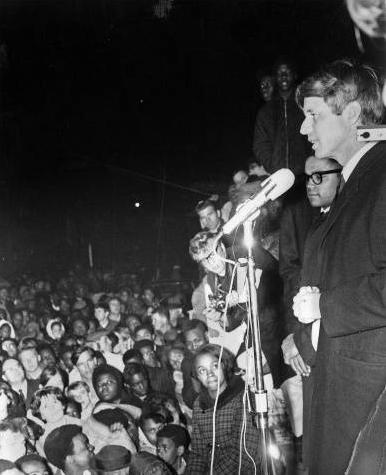On the evening of April 4, 1968, as more than a hundred cities erupted in violence following the murder of Martin Luther King Jr., Senator Robert F. Kennedy (D-N.Y.) stood before a mostly African American audience in Indianapolis and made a moving personal appeal for calm that won national acclaim.

Kennedy had come seeking votes in Indiana’s May presidential primary. Since state Democratic leaders opposed his candidacy, Kennedy’s staff had arranged a campaign appearance in the heart of an Indianapolis African American neighborhood to cement backing from Black voters who valued the senator’s support for minorities and the disadvantaged.
Fearing violence, city officials unsuccessfully urged Kennedy to cancel his speech. When he arrived at 17th Street and Broadway, the festive crowd of about 2,500 had not heard of King’s death. Speaking extemporaneously from the back of a truck, Kennedy began with the shocking announcement. He recalled that he had a member of his family killed by a white man and asked the crowd to join him in prayer for the nation and in the determination to replace savageness with gentleness in the world. It was a defining moment for both Kennedy and the city.
Indianapolis’ Mayor Richard Lugar credited Charles Snookie Hendricks and his group of activists with maintaining peace in Indianapolis in the wake of Dr. Martin Luther King Jr. ‘s assassination on April 4, 1968. Hendricks and approximately 200 members of various Black activist groups, including the Black Radical Action Project of Indianapolis were in attendance. of Kennedy’s speech. Fearful for Kennedy’s life, Hendricks quickly recruited attendees to scan the area for possible assassins. Because of the strong relationship Lugar formed with Hendricks, the activist worked to maintain calm among the crowd not only during the Kennedy speech but in the days after which meant Indianapolis did not experience the hostility that erupted in the wake of King’s assassination as many parts of the United States did.
Kennedy won the Indiana primary but fell victim himself to an assassin in California on June 6. His remarks of April 4 became an epitaph proclaiming his vision for America: a portion of the speech is inscribed on a memorial wall adjoining his gravesite at Arlington National Cemetery. For Indianapolis, the speech helped preserve the city as an island of restraint in the turbulent aftermath of the King assassination.
The park where Kennedy made the speech was renamed Martin Luther King Jr. Park. In 1995, President Bill Clinton dedicated the “Landmark for Peace” in the park to commemorate the speech and to honor Kennedy and King. In 2018, President Donald Trump designated it the Kennedy-King National Commemorative Site.

Help improve this entry
Contribute information, offer corrections, suggest images.
You can also recommend new entries related to this topic.

